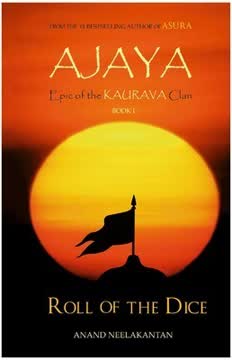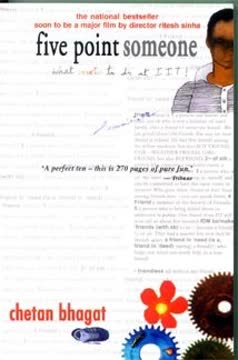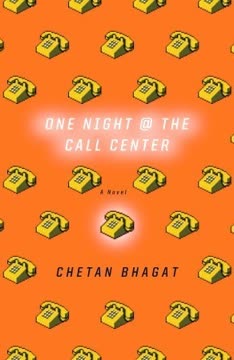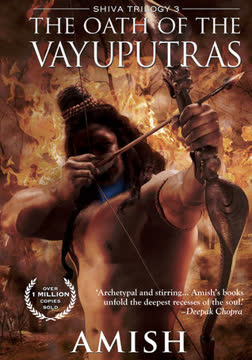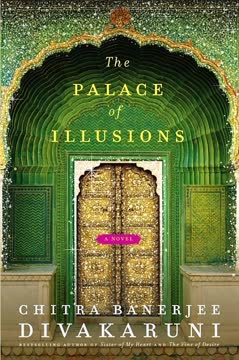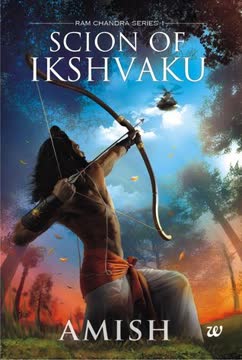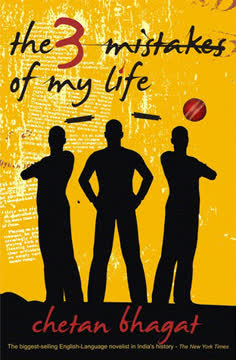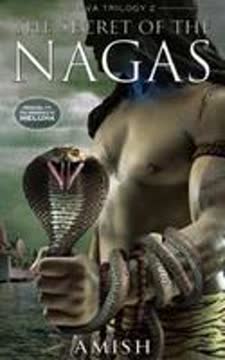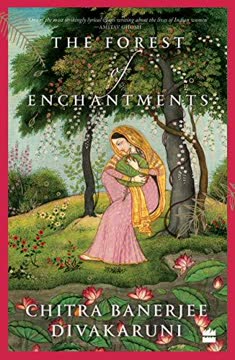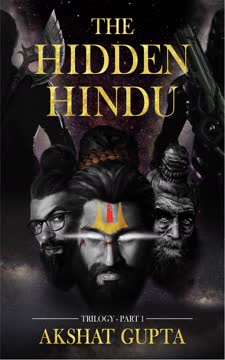Plot Summary
Blood and Betrayal
The story opens with the conquest of Gandhara by Bhishma, the Grand Regent of Hastinapura, who forcibly takes Gandhari as bride for his blind nephew, Dhritarashtra. This act of violence and humiliation plants the seeds of vengeance in Gandhari's brother, Shakuni, who is brought to Hastinapura as a child. The Kuru dynasty is thus founded on a legacy of blood, betrayal, and the subjugation of the weak by the powerful. The palace becomes a crucible of simmering resentments, with Gandhari's silent suffering and Shakuni's growing hatred shaping the destinies of the next generation. The children of the palace—Kauravas and Pandavas—grow up in an atmosphere thick with rivalry, suspicion, and the ever-present shadow of caste as destiny and legitimacy. The stage is set for a generational conflict that will engulf the entire land.
The Outcast's Dream
In the forests outside Hastinapura, Ekalavya, a Nishada (tribal outcast), dreams of becoming a great archer. His life is marked by poverty, hunger, and the daily humiliations of caste. A chance encounter with Prince Suyodhana (later known as Duryodhana) reveals a rare moment of kindness, as the prince gives Ekalavya food. This act, though small, ignites in Ekalavya a burning desire to rise above his station. He becomes obsessed with learning the art of war, even as society and the Brahmin teachers deny him access. Ekalavya's journey is one of relentless self-improvement, fueled by both resentment and hope, as he seeks dignity for himself and his people in a world that refuses to see their humanity.
Seeds of Rebellion
The rigid caste system of Hastinapura breeds not only personal anguish but also collective unrest. The palace is a microcosm of a society where birth determines destiny, and merit is stifled by tradition. Suyodhana, the legitimate heir, is constantly undermined by the claims of his Pandava cousins, whose divine parentage is both a political tool and a source of resentment. The arrival of Guru Drona, a Brahmin obsessed with purity and hierarchy, further entrenches these divisions. Meanwhile, in the shadows, Takshaka and the Nagas plot rebellion, seeking to overturn the social order and avenge centuries of oppression. The seeds of civil war are sown, as the marginalized begin to organize against the entrenched elite.
The Charioteer's Son
Karna, the son of a charioteer, is another victim of the caste system's cruelty. Gifted and ambitious, he yearns to become a warrior but is repeatedly humiliated and denied by the Brahmin teachers. His only solace comes from the maverick Kripa, who teaches him that true worth is not determined by birth. Karna's journey takes him south to learn from Parashurama, the greatest living warrior, by pretending to be a Brahmin. His life is a constant negotiation between his talent and the world's refusal to acknowledge it. Karna's friendship with Suyodhana becomes a lifeline, as the prince recognizes his merit and elevates him, setting the stage for a rivalry with Arjuna that will define the fate of empires.
Caste and Ambition
The Kuru palace is a theater of competing ambitions and philosophies. Suyodhana, shaped by both privilege and exclusion, questions the legitimacy of the Pandavas and the hypocrisy of the Brahmins. His uncle Shakuni fans the flames of resentment, teaching him the art of intrigue and the necessity of power. The Pandavas, guided by their mother Kunti and the priest Dhaumya, are equally ruthless in their pursuit of the throne. The struggle for succession is not just a family feud but a clash of worldviews: merit versus birth, reform versus orthodoxy, and compassion versus tradition. The personal becomes political, as every slight and insult is magnified into a cause for war.
The Teacher's Cruelty
Guru Drona, the royal teacher, embodies the contradictions of a society obsessed with purity. He is a brilliant warrior but a narrow-minded bigot, who refuses to teach Karna and Ekalavya because of their low birth. Ekalavya, undeterred, teaches himself by observing Drona's lessons from afar, eventually surpassing even Arjuna in skill. When Drona discovers this, he demands Ekalavya's right thumb as "gurudakshina," crippling the boy and ensuring that only the high-born may excel. This act of cruelty becomes a symbol of the system's violence against the talented but marginalized. The lesson is clear: in this world, greatness is permitted only to those of the right lineage.
The Making of Enemies
As the princes grow, so do their enmities and alliances. Suyodhana's friendship with Karna and Aswathama (Drona's son) becomes a counterweight to the Pandavas' bond with Krishna, the enigmatic Yadava prince. The palace is rife with plots: Shakuni's manipulations, Kunti's political marriages, and the constant jockeying for favor among teachers and priests. The marginalized—Karna, Ekalavya, and the Nagas—find in Suyodhana a champion, while the Pandavas consolidate their power through strategic marriages and alliances. The lines are drawn for a conflict that is as much about ideas as it is about blood.
The Unconquerable Prince
Suyodhana emerges as a complex and charismatic leader, determined to challenge the orthodoxy and create a more just society. He dreams of a world where merit is recognized, and the poor and outcast are given dignity. His coronation of Karna as King of Anga is a revolutionary act, breaking centuries of tradition. Suyodhana's vision is both inspiring and dangerous, as it threatens the foundations of the established order. His enemies brand him "Duryodhana"—the evil one—but to his followers, he is "Ajaya," the unconquerable. His struggle is not just for a throne, but for the soul of a civilization.
The Price of Kindness
Acts of compassion in this world are often punished. Suyodhana's kindness to Ekalavya and Karna brings him enemies among the elite. Ekalavya's generosity to a beggar leads to betrayal and loss. The palace is a place where every good deed is suspect, and every act of mercy is seen as weakness. The marginalized learn that survival requires cunning, and that the world is quick to crush those who dare to dream. The lesson is harsh: in a society built on hierarchy and suspicion, kindness is a dangerous luxury.
The Forest Burns
The Pandavas, with Krishna's guidance, burn down the Khandiva forest to build their new city, Indraprastha. The act is both literal and symbolic: the old world of tribes, animals, and outcasts is sacrificed for the sake of civilization. The survivors—Nagas, Nishadas, and others—are driven into the slums, their labor exploited to build the palaces and temples of the new order. The city is a marvel, but it is built on the bones of the dispossessed. The curse of Mayasura, the architect, hangs over Indraprastha: a city founded on injustice can never know peace.
The Rise of Karna
Karna's rise from outcast to king is a testament to his talent and determination, but also to the generosity of Suyodhana. Yet, his triumph is always shadowed by the stigma of his birth. At Draupadi's swayamvara, he is publicly humiliated and denied the bride he loves, despite winning the contest. His charity and valor win him fame, but never acceptance. The world is quick to remind him of his origins, and his greatest rival, Arjuna, is always one step ahead, aided by divine favor and political machinations. Karna's tragedy is that in a world obsessed with purity, merit alone is never enough.
The Game of Dice
The rivalry between Suyodhana and the Pandavas culminates in a game of dice, orchestrated by Shakuni. Yudhishtra, the eldest Pandava, is lured into gambling away his kingdom, his brothers, and finally his wife, Draupadi. The game is rigged, but the rules of dharma and honor are twisted to justify every outrage. The sabha (court) becomes a theater of humiliation, as the Pandavas are stripped of everything, and Draupadi is dragged into the hall and threatened with public disrobing. The dice roll not just for property, but for the very soul of the nation.
The Humiliation of Draupadi
Draupadi's public humiliation is the nadir of the Kuru dynasty. The men of the court—kings, priests, and warriors—stand by as she is insulted and threatened. The rules of dharma are invoked to justify her degradation, and the silence of the elders is deafening. The event shatters any pretense of justice or righteousness in the kingdom. Draupadi's curse and her demand for vengeance become the rallying cry for the coming war. The moral bankruptcy of the elite is laid bare, and the seeds of destruction are sown.
The City of Illusions
The Pandavas' new city is a marvel of architecture and wealth, but it is also a city of illusions. The poor and outcast are banished to the slums, their labor exploited and their suffering ignored. The city's splendor is built on the bones of the dispossessed, and its gods are blind to the misery outside the palace walls. The curse of Mayasura, the architect, hangs over the city, as the rulers become increasingly detached from the people they claim to serve. The city is a microcosm of a civilization in decline, where appearances mask a rotting core.
The Curse of Indraprastha
As Indraprastha flourishes, the cracks in its foundation widen. The marginalized—Nagas, Nishadas, and others—are driven to rebellion. The priests and Brahmins grow ever more powerful, manipulating the rulers and justifying every injustice in the name of dharma. The city's rulers are trapped in a web of rituals, debts, and political intrigue. The curse of the architect becomes a prophecy: a city built on exclusion and suffering cannot endure. The stage is set for a cataclysmic war that will consume everything.
The March to War
The humiliation of Draupadi and the injustice of the dice game ignite a firestorm of resentment and rage. The marginalized and the dispossessed rally to the banners of rebellion, while the elite prepare for a war that will decide the fate of the world. Old alliances are broken, and new ones are forged in blood. The Southern Confederate, the Nagas, and the outcast armies gather for the final reckoning. The rulers of Indraprastha and Hastinapura are trapped in a cycle of vengeance and retribution, unable to break free from the past.
The Vanquished and the Damned
As the war looms, the characters reflect on the choices that have brought them to this point. Suyodhana, Karna, Ekalavya, and the others who fought for dignity and justice are branded as villains and traitors. The victors write the history, but the vanquished know the truth: they fought not for power, but for a world where merit and compassion mattered. The story ends with a sense of tragic inevitability, as the dice roll one last time and the world plunges into darkness. The lesson is clear: a civilization that refuses to see the humanity of its weakest members is doomed to destroy itself.
Characters
Suyodhana (Duryodhana)
Suyodhana, often maligned as Duryodhana, is reimagined as a complex, passionate, and visionary leader. He is the legitimate heir to Hastinapura, but is constantly undermined by the claims of his Pandava cousins and the machinations of the Brahmin elite. Suyodhana's psychological landscape is shaped by both privilege and exclusion: he is a prince, yet always reminded of his father's blindness and his own supposed inadequacy. His friendship with Karna and Aswathama is both a source of strength and a political liability. Suyodhana's greatest flaw is his inability to forgive insults, but his greatest virtue is his commitment to justice and merit. He dreams of a world where birth does not determine destiny, and his struggle is as much against the system as it is against his rivals. His downfall is the result of both his own hubris and the implacable forces of tradition and orthodoxy.
Karna
Karna is the son of a charioteer, but his true parentage is shrouded in mystery. Gifted, generous, and fiercely proud, Karna is the ultimate outsider: always striving for recognition, always denied acceptance. His psychological torment is rooted in the knowledge that no matter how much he achieves, he will never be seen as equal by the elite. His friendship with Suyodhana is both a lifeline and a curse, as it brings him power but also makes him a target. Karna's rivalry with Arjuna is both personal and symbolic: a contest between merit and privilege, talent and birth. His tragedy is that he is always forced to choose between loyalty and justice, and his greatest acts of generosity are often punished by fate.
Ekalavya
Ekalavya is a Nishada, an outcast by birth, but a genius by nature. His hunger for dignity and skill drives him to teach himself archery by observing Drona's lessons from afar. His psychological journey is one of relentless self-improvement, fueled by both resentment and hope. Ekalavya's sacrifice of his thumb at Drona's demand is a searing indictment of a society that cripples its most talented members. His later turn to rebellion is both a personal and political act, as he seeks justice for himself and his people. Ekalavya embodies the pain and potential of the marginalized, and his story is a reminder of the cost of exclusion.
Shakuni
Shakuni is the brother of Gandhari, brought to Hastinapura as a child after the conquest of his homeland. His psychological landscape is shaped by trauma, humiliation, and a burning desire for revenge. Shakuni is a master of intrigue, using his skills at dice and manipulation to undermine the Kuru dynasty from within. He is both a villain and a tragic figure: a man who seeks justice for his people but becomes consumed by hatred. His relationship with Suyodhana is both paternal and poisonous, as he teaches the prince the art of power but also the necessity of ruthlessness.
Bhishma
Bhishma is the Grand Regent of Hastinapura, a man of immense power and wisdom, but also of crippling self-restraint. His vow of celibacy and loyalty to the throne make him both a pillar of stability and a symbol of the system's inability to change. Bhishma's psychological torment is rooted in his awareness of the system's flaws, but his inability to act decisively. He is both a protector and a bystander, watching as the kingdom he loves slides into chaos. His relationship with Suyodhana is paternal but distant, and his failure to intervene at key moments is a source of lasting regret.
Drona
Drona is a Brahmin warrior, obsessed with purity and tradition. He is a master of arms but a narrow-minded bigot, who refuses to teach those of low birth. His psychological complexity lies in his simultaneous admiration for talent and his fear of social change. Drona's cruelty to Ekalavya and Karna is both personal and systemic: he is the enforcer of a world where only the high-born may excel. His love for his son Aswathama is both a strength and a weakness, as it blinds him to the consequences of his actions.
Draupadi
Draupadi is the daughter of King Dhrupada, won by Arjuna at her swayamvara but forced to marry all five Pandavas. She is intelligent, proud, and fiercely independent, but is repeatedly humiliated and used as a pawn in the games of men. Her psychological journey is one of resilience and rage, as she refuses to accept her fate quietly. Draupadi's public humiliation in the dice game becomes the catalyst for the coming war, and her demand for justice is a rallying cry for the oppressed.
Krishna
Krishna is a Yadava prince, worshipped as an avatar of Vishnu by many. He is a master of strategy, manipulation, and oratory, always several steps ahead of his rivals. Krishna's psychological complexity lies in his ability to justify any means for the sake of what he sees as the greater good. He is both a savior and a destroyer, a friend to the Pandavas and a nemesis to Suyodhana and Karna. His vision of order is both inspiring and terrifying, as it leaves little room for dissent or ambiguity.
Aswathama
Aswathama is the son of Drona, torn between loyalty to his father and friendship with Suyodhana. He is intelligent, passionate, and often at odds with the system he serves. His psychological journey is one of constant negotiation between duty and desire, tradition and rebellion. Aswathama's loyalty to Suyodhana and Karna makes him an outcast among the elite, but also a symbol of the possibility of change.
Vidhura
Vidhura is the Prime Minister of Hastinapura, born of a low-caste mother but recognized for his wisdom and integrity. He is the voice of reason and moderation in a world gone mad, but his advice is often ignored or resented. Vidhura's psychological burden is the knowledge that merit is never enough in a world obsessed with birth. He is both a participant and a bystander, always trying to do the right thing but rarely able to change the course of events.
Plot Devices
Inversion of the Epic
The novel's central device is the inversion of the traditional Mahabharata narrative, telling the story from the perspective of the Kauravas and the marginalized. This shift in viewpoint exposes the biases and hypocrisies of the victors' version, and invites the reader to question the nature of justice, heroism, and villainy. The familiar events—dice game, Draupadi's humiliation, the burning of the forest—are reinterpreted as acts of systemic violence against the weak.
Caste as Destiny
The novel uses the caste system not just as a backdrop, but as a central engine of conflict. Characters' ambitions, relationships, and fates are all shaped by the rigid hierarchies of birth. The psychological impact of exclusion and humiliation is explored in depth, as is the way the system perpetuates itself through both violence and ideology.
Foreshadowing and Irony
The narrative is rich in foreshadowing, with early acts of violence and exclusion setting the stage for later catastrophe. The irony of the "righteous" Pandavas building their city on the bones of the dispossessed, or of the dice game being justified by dharma, is used to devastating effect. The blindness of Dhritarashtra becomes a metaphor for the moral blindness of the elite.
The Outsider's Gaze
By centering the stories of Karna, Ekalavya, and the Nagas, the novel invites the reader to see the world through the eyes of the excluded. Their struggles and aspirations become a mirror for the society's failures, and their ultimate defeat is a condemnation of a civilization that refuses to change.
The Game of Dice
The dice game is both a literal event and a metaphor for the randomness of fate and the illusion of meritocracy. The rigged game exposes the emptiness of the system's claims to justice
Last updated:
FAQ
Synopsis & Basic Details
What is Ajaya: Roll of the Dice about?
- An Inverted Epic Narrative: Ajaya: Roll of the Dice reimagines the foundational Indian epic, the Mahabharata, from the perspective of the often-maligned Kauravas, particularly focusing on Suyodhana (Duryodhana). It portrays him not as a villain, but as a complex, principled, and misunderstood leader fighting against a hypocritical and caste-ridden system.
- Struggle for Justice: The novel chronicles Suyodhana's fight for his birthright against his Pandava cousins, who are presented as manipulative and self-serving, often using 'dharma' as a pretext for their ambitions. It highlights the struggles of marginalized characters like Karna and Ekalavya, whose talents are stifled by societal prejudice.
- Seeds of a Great War: The narrative builds towards the inevitable conflict, detailing the political intrigues, personal betrayals, and ideological clashes that set the stage for the Kurukshetra War. It explores themes of caste, power, morality, and the human cost of ambition, all through the eyes of those traditionally cast as the 'vanquished.'
Why should I read Ajaya: Roll of the Dice?
- Fresh Perspective on Mythology: Readers seeking a radical reinterpretation of the Mahabharata will find this book compelling, as it challenges conventional notions of good and evil, hero and villain, offering a nuanced portrayal of characters like Suyodhana and Karna. This Ajaya: Roll of the Dice analysis provides a unique lens on familiar tales.
- Deep Dive into Societal Themes: The novel masterfully explores profound themes such as the rigidity of the caste system, the corruption of power, the true meaning of dharma, and the psychological impact of prejudice, making it highly relevant for contemporary discussions on social justice and inequality.
- Engaging Character Development: Anand Neelakantan crafts deeply human characters, allowing readers to empathize with their struggles, motivations, and flaws, regardless of their traditional epic roles. The emotional depth and internal conflicts of figures like Suyodhana, Karna, and Drona are particularly captivating.
What is the background of Ajaya: Roll of the Dice?
- Reimagining Ancient Indian Epic: The novel is set in the backdrop of the Mahabharata, an ancient Indian epic, but subverts its traditional narrative by telling the story from the perspective of the Kauravas. This Mahabharata retelling challenges the established moral framework, presenting the 'vanquished' side with empathy and justification.
- Critique of Caste and Power: The story is deeply rooted in the socio-political landscape of ancient India, where the rigid caste system dictated destiny and power was often concentrated in the hands of a few. The author uses this setting to critique the hypocrisy and injustice inherent in such a system, highlighting the struggles of the marginalized.
- Author's Personal Motivation: Anand Neelakantan was inspired by a temple in Kerala dedicated to Duryodhana, where he is worshipped as a protector of the weak. This personal encounter led him to question the conventional portrayal of Duryodhana and explore the epic from a different, more humanistic viewpoint, as detailed in the "Author's Note."
What are the most memorable quotes in Ajaya: Roll of the Dice?
- "There is no caste for hunger and thirst.": Spoken by Duryodhana in the author's note, this quote encapsulates the novel's core theme of challenging caste prejudice and highlights Duryodhana's inherent compassion, setting the tone for his characterization as a reformer.
- "Life is a gamble. You do not know how the dice will fall. But once they have, how you move the pieces is in your hands.": Kripa's philosophical advice to Karna (Chapter 5) profoundly reflects the theme of agency versus fate, emphasizing that while circumstances are given, one's response defines their destiny, a central idea in Karna's motivations.
- "The path you are choosing will lead us all to disaster.": Bhanumati's prophetic warning to Suyodhana (Chapter 27) underscores the tragic inevitability of the impending war, highlighting the personal cost of political ambition and the destructive nature of unchecked pride, a key element in themes in Ajaya: Roll of the Dice.
What writing style, narrative choices, and literary techniques does Anand Neelakantan use?
- Third-Person Omniscient Perspective: The narrative employs a third-person omniscient point of view, allowing the reader access to the inner thoughts and motivations of a wide array of characters, from kings to beggars. This technique is crucial for the inversion of the epic, providing depth and empathy to characters traditionally seen as villains.
- Rich, Evocative Prose with Sensory Details: Neelakantan uses vivid descriptions of landscapes, emotions, and actions, immersing the reader in the ancient world. Sensory details, such as the "ripe smell of sweet mangoes" (Chapter 2) or the "stench of putrefying flesh" (Chapter 26), create a visceral experience, enhancing the emotional impact of the story.
- Symbolism and Foreshadowing: The novel is replete with symbolism, from Shakuni's dice representing manipulation and fate, to the burning of Khandiva forest symbolizing the destruction of the old order. Constant foreshadowing through dreams, omens, and prophetic warnings (e.g., Mayasura's curse, Kripa's warnings) builds tension and underscores the tragic inevitability of the unfolding events.
Hidden Details & Subtle Connections
What is the significance of Jara and his blind dog Dharma?
- Symbol of Unconditional Devotion: Jara, the deformed beggar, and his blind dog, Dharma, represent the purest form of devotion and gratitude, often in stark contrast to the self-serving piety of the elite. Jara's unwavering faith in Krishna, despite his suffering, highlights the novel's critique of superficial religiosity and the true meaning of compassion.
- Moral Compass for Protagonists: Their recurring presence acts as a subtle moral barometer for characters like Suyodhana and Karna. Suyodhana's kindness to Jara (Chapter 26) and Karna's profound guilt after being saved by him (Chapter 17, 21) reveal their inherent goodness, often obscured by their ambition or the machinations of others.
- Embodiment of the Downtrodden: Jara and Dharma symbolize the forgotten masses, the "Untouchables" whose lives are deemed worthless by society, yet who possess a profound spiritual understanding. The dog being named "Dharma" (Chapter 15) is a powerful irony, suggesting that true righteousness resides not in caste or ritual, but in humility and love, a key aspect of Ajaya: Roll of the Dice symbolism.
How does the symbolism of Shakuni's dice deepen his character and the plot?
- Instrument of Calculated Vengeance: Shakuni's dice, crafted from his slain father's thighbone, are not merely tools of chance but instruments of his meticulously planned revenge against Hastinapura. Their ability to obey his command ("I call 'Four!' and they fall in perfect fours," Chapter 11) symbolizes his absolute control and the predetermined nature of his destructive agenda.
- Representation of Manipulated Fate: The dice embody the theme that fate can be manipulated by cunning and malice. While others believe in destiny, Shakuni actively engineers events, using the dice as a psychological weapon to exploit Yudhishtra's gambling addiction and the Kuru's internal divisions, central to Shakuni's motivations.
- Echo of Gandhara's Humiliation: The dice serve as a constant, visceral reminder of Gandhara's conquest and his family's suffering. Each roll is an act of defiance and a step towards dismantling the empire that wronged him, transforming a personal vendetta into a larger geopolitical strategy, a crucial element in themes in Ajaya: Roll of the Dice.
What subtle details foreshadow the moral decay of the Pandavas?
- Arjuna's Indifference to Life: Early in the narrative, Arjuna's unwavering focus on hitting a bird's eye, even as Suyodhana sees "love" in its eyes (Chapter 7), subtly foreshadows his later detachment from the human cost of war. His willingness to kill without question, even innocent creatures, hints at a moral blindness that will escalate.
- Yudhishtra's Justification of Cruelty: Yudhishtra's calm rationalization of sacrificing the Nishada family in the House of Lac (Chapter 20) and his explanation of "Apat dharma" (duty in distress) reveal a chilling pragmatism. This foreshadows his later moral compromises, where the 'greater good' or 'dharma' is twisted to justify ruthless actions, a key aspect of Yudhishtra's motivations.
- Krishna's Calculated Detachment: Krishna's philosophical stance of "Stithapranja" (remaining calm in all circumstances) and his belief that "death is but an illusion" (Chapter 8) allows him to orchestrate violence without emotional consequence. His tearing of the betel leaf to instruct Bhima to dismember Jarasandha (Chapter 23) is a subtle yet brutal foreshadowing of his manipulative and detached approach to life and death.
What is the deeper meaning behind Mayasura's curse on Indraprastha?
- Prophecy of Inherent Corruption: Mayasura's curse (Chapter 24) is a powerful prophecy that Indraprastha, despite its outward splendor, is fundamentally flawed due to its foundation on injustice and the suffering of the marginalized. His words, "May no woman feel safe in this city. May corrupt and evil people forever rule this wretched place," directly foretell the moral decay and violence that will plague the city and its rulers.
- Symbol of Exploited Labor: The architect's anguish stems from seeing his people, the Nagas, Nishadas, and other "Untouchables," exploited and banished after building the city. The curse highlights the theme of civilization built on the backs of the dispossessed, where the beauty of creation is tainted by the ugliness of its origins, a critical Indraprastha analysis.
- Critique of Superficial Progress: Mayasura's lament that the "Gods are blind" and his desire to "open their eyes" (Chapter 24) symbolizes the spiritual emptiness of a society that prioritizes material grandeur and ritual purity over genuine compassion and equality. The curse serves as a stark reminder that true progress cannot be achieved through exclusion and violence.
Psychological, Emotional, & Relational Analysis
Explore the psychological complexities of Suyodhana's character.
- Noble Heart vs. Burning Pride: Suyodhana is deeply compassionate, evident in his kindness to Ekalavya (Chapter 2) and his defense of Karna (Chapter 18), yet he possesses a fierce pride that makes him unable to tolerate insult. This internal conflict drives many of his actions, as he struggles to reconcile his innate goodness with the demands of his royal status and the slights he endures.
- Vulnerability and Insecurity: Despite his outward arrogance, Suyodhana harbors deep insecurities stemming from his father's blindness and the constant undermining of his legitimacy by the Pandavas and their allies. His depression after Subhadra's betrayal (Chapter 22) reveals a profound emotional vulnerability, making him susceptible to Shakuni's manipulations for revenge.
- Visionary Reformer with Flawed Execution: Suyodhana genuinely dreams of a meritocratic society free from caste prejudice, as articulated during Karna's coronation (Chapter 18). However, his impulsiveness, anger, and susceptibility to personal slights often lead him to adopt morally ambiguous methods, blurring the lines between his noble intentions and the destructive path he ultimately takes. This is central to Suyodhana's motivations.
Analyze Karna's emotional journey and his internal conflicts.
- Shame of Birth vs. Pride in Achievement: Karna's emotional core is defined by the constant tension between the shame of his low-caste birth and the immense pride he takes in his unparalleled skill and generosity. His initial desire to commit suicide (Chapter 4) after being denied by Kripa, and his later elation at becoming King of Anga (Chapter 18), vividly illustrate this struggle for self-worth.
- Loyalty vs. Personal Desire: Karna grapples with conflicting loyalties: to his adoptive parents, to his friend Suyodhana, and to his own heart's desires, particularly his love for Draupadi. His silent suffering after Draupadi's public rejection (Chapter 21) and his subsequent act of charity to the poor reveal a profound emotional wound and a search for meaning beyond personal glory.
- Search for Acceptance and Identity: Throughout his journey, Karna yearns for acceptance, not just for his skills, but for his true self. His deception to learn from Parashurama (Chapter 13) and his later embrace of his Suta identity, even while being a king, highlight his complex quest for identity in a society that constantly judges him by his lineage, a key aspect of Karna's motivations.
How does Gandhari's voluntary blindness symbolize her internal struggle?
- Protest Against Injustice: Gandhari's decision to blindfold herself (Prelude) is initially an act of profound protest against Bhishma's forced marriage and the injustice done to her homeland, Gandhara. It symbolizes her refusal to acknowledge a world built on violence and subjugation, a silent rebellion against her fate.
- Shared Burden and Empathy: Her blindness evolves into a symbol of shared suffering with her blind husband, Dhritarashtra, and a deep empathy for his insecurities. It represents her commitment to her chosen family, even as she secretly harbors resentment towards the circumstances that led her there, revealing the depth of Gandhari's motivations.
- Moral Blindness and Maternal Love: While her physical blindness is voluntary, it also subtly reflects a moral blindness, particularly concerning her sons. Her inability to see Suyodhana's flaws or Shakuni's manipulations, despite her deep maternal love, foreshadows the tragic consequences of her inaction and her family's downfall, a crucial element in themes in Ajaya: Roll of the Dice.
Examine the evolving relationship dynamics between Suyodhana and his allies.
- Suyodhana and Karna: A Bond of Mutual Respect: Their relationship transcends caste and expectation, founded on Suyodhana's recognition of Karna's merit and Karna's unwavering loyalty. Suyodhana's act of crowning Karna as King of Anga (Chapter 18) solidifies a bond that challenges societal norms, making them formidable allies against the Pandavas.
- Suyodhana and Aswathama: Friendship Beyond Family: Aswathama, Drona's son, consistently chooses friendship with Suyodhana over loyalty to his own father and the Pandavas. Their shared disdain for hypocrisy and the caste system, coupled with Aswathama's playful mockery and unwavering support, highlights a bond of genuine affection and intellectual camaraderie.
- Shakuni's Manipulative Influence: Shakuni acts as a poisonous mentor, exploiting Suyodhana's pride and insecurities to fuel his own agenda of revenge against Hastinapura. While Suyodhana initially resists his uncle's darker suggestions (Chapter 11), Shakuni's constant presence and strategic advice gradually erode Suyodhana's moral compass, turning him towards cunning and deceit, a key aspect of Shakuni's motivations.
What are the unspoken motivations behind Krishna's actions?
- Preservation of a Specific 'Dharma': Krishna's primary, often unspoken, motivation is to preserve a specific interpretation of 'dharma' and the social order (chaturvarna), even if it requires ruthless manipulation and violence. He believes he is an "avatar of Vishnu" (Chapter 8) destined to restore balance, justifying his actions as necessary for the greater cosmic good, a central aspect of Krishna's motivations.
- Strategic Elimination of Opposition: Krishna systematically works to eliminate anyone who challenges his vision of social order or the Pandavas' ascent to power. His orchestration of Jarasandha's death (Chapter 23) and his calculated advice to Arjuna regarding Subhadra (Chapter 22) demonstrate a cold, pragmatic approach to achieving his goals, regardless of personal cost or moral ambiguity.
- Cultivation of Divine Image: Krishna actively cultivates his image as a divine being and miracle worker, using propaganda and strategic interventions to gain followers and legitimize his actions. His ability to pacify soldiers with philosophical arguments after Jarasandha's murder (Chapter 23) and his enchanting flute music (Chapter 8) are tools to sway public opinion and consolidate his influence.
Interpretation & Debate
How does the novel challenge traditional notions of 'dharma'?
- Dharma as a Tool of Oppression: The novel consistently portrays 'dharma' not as universal righteousness, but as a flexible concept manipulated by the powerful (Brahmins, Pandavas, Krishna) to maintain their privilege and justify their actions. Dhaumya's pronouncements on caste rules and Yudhishtra's rationalization of sacrificing the Nishada family (Chapter 20) expose this hypocrisy.
- Individual Conscience vs. Scriptural Authority: Characters like Suyodhana and Kripa embody a 'dharma' rooted in compassion and individual conscience, often clashing with the rigid, scriptural interpretations. Suyodhana's refusal to harm a disarmed Bhima (Chapter 18) and Kripa's open defiance of caste rules (Chapter 5) highlight a more humane, albeit often punished, understanding of righteousness.
- The 'Dharma' of the Vanquished: The narrative implicitly argues for a 'dharma' of survival and dignity for the marginalized. Karna's struggle for recognition, Ekalavya's self-taught mastery, and Mayasura's curse on Indraprastha represent a counter-narrative where the traditional 'dharma' fails to protect the weak, leading to their own forms of resistance and justice. This is a core themes in Ajaya: Roll of the Dice debate.
What are some debatable, controversial scenes or moments in Ajaya: Roll of the Dice?
- Ekalavya's Thumb Sacrifice (Chapter 14): Drona's demand for Ekalavya's right thumb as gurudakshina is a deeply controversial act. The novel frames it as a brutal enforcement of caste hierarchy, crippling a talented individual to preserve Arjuna's supremacy. This scene sparks debate on whether Drona's actions were justified by his promise to Arjuna or a heinous act of prejudice, central to Drona's motivations and Ekalavya's analysis.
- The House of Lac Incident (Chapter 20): The burning of the House of Lac, resulting in the death of a Nishada woman and her five children, is presented as a morally ambiguous event. While Kunti and Yudhishtra justify it as "Apat dharma" (duty in distress) to escape Suyodhana's supposed plot, the novel highlights the callous sacrifice of innocent lives for political gain, raising questions about the Pandavas' righteousness.
- Draupadi's Rejection of Karna (Chapter 21): Draupadi's public refusal to marry Karna at her swayamvara, solely due to his low caste, is a pivotal and controversial moment. It exposes the deep-seated prejudice even within a spirited character and fuels Karna's bitterness, leading to his later cruel remarks. This scene challenges the reader to question the purity of Draupadi's character and the societal values she upholds.
Ajaya: Roll of the Dice Ending Explained: How It Ends & What It Means
- The Inevitable Descent into War: The book concludes with the "Roll of the Dice" (Chapter 27) where Yudhishtra gambles away everything, including Draupadi, to Shakuni. This act, driven by pride and addiction, is the final catalyst for the Great War, signifying that the conflict is not just about land or power, but the complete moral and social breakdown of the Kuru dynasty.
- Shakuni's Triumph of Vengeance: Shakuni's smug satisfaction as the dice fall in his favor, and his internal monologue about the impending "apocalypse" and "total destruction of this cursed land," reveals his ultimate success in orchestrating the downfall of Hastinapura. The dice, made from his father's thighbone, symbolize his long-awaited revenge for Gandhara's humiliation.
- The Seeds of Kali Yuga: The ending foreshadows the coming of the Kali Yuga, an age of moral decay and chaos, where traditional values are inverted. The humiliation of Draupadi, the moral compromises of the Pandavas, and Suyodhana's descent into bitterness, all point to a world where righteousness is lost, and a devastating war is the only outcome, leaving readers to ponder the true meaning of Ajaya: Roll of the Dice ending explained.
Review Summary
Ajaya retells the Mahabharata from Duryodhana's perspective, challenging traditional interpretations. Readers appreciate the fresh take on familiar characters and events, praising Neelakantan's writing style and character development. Some criticize the extreme portrayal of Duryodhana as purely good and the Pandavas as villains, feeling it oversimplifies the epic's complexity. The book's exploration of caste and societal issues resonates with many readers. While some find it thought-provoking and engaging, others feel it deviates too far from the original story. Overall, it's a polarizing but intriguing reimagining of the classic tale.
Epic of the Kaurava Clan Series
Similar Books
Download PDF
Download EPUB
.epub digital book format is ideal for reading ebooks on phones, tablets, and e-readers.
